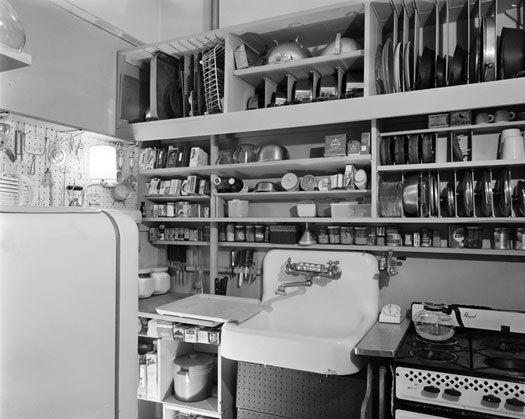
From Eames + Valastro: Design in the Life of an American Family by Daniel Ostroff
I love this kitchen. Everything has its place. Everyday supplies within reach. Coffee over the coffee pot. Can opener at the ready. This is a modernist's dream, but also a housewife's dream. This photograph is from a small, charming new book titled Eames + Valastro: Design in the Life of an American Family. In it, Eames collector and historian Daniel Ostroff interviews the sons of the owner and creator of that kitchen, Gladys Valastro. Their interview is the story of the nine pieces of Eames furniture that their parents bought in 1954, but more importantly, the story of living as with design as a middle-class American family. Turning a fiberglass rocker into a turtle. Surfing a molded plywood coffee table. Sleeping a baby in the drawer of an ESU. Once upon a time these pieces weren't icons, and it is important to be reminded that they could take it. I see this book as part of a larger reconsideration of the Eameses, including the huge monograph of last winter (which I reviewed critically here), and the new documentary Eames: The Architect and the Painter (which Martin Filler reviewed critically here). I'll definitely write about the film when I see it.
What's also interesting in the sons' account is how natural modern design came to seem to them, and how little they understood their mother's skills as a designer until they were grown up. They just lived it. Gladys Valastro was trained at the Pratt Institute in interior design, and her master's thesis was the design of a kitchen for people in wheelchairs, circa 1945, for the Rusk Institute. She put the same design thinking into her own home, assembling, arranging and rearranging their nine coveted Eames elements so that the silverware was next to the table, the records below the turntable.
James Valastro: With Mom it was like if you're in the kitchen in Indian Lake today, and you're standing there, and you say, "God, I need a can opener," you should never move your feet... You look in the drawer and you open the most obvious place and most of the time, that is where the thing is.
Kenneth Valastro: Mom was also fanatical about stuff being easy to clean. She'd look at something and she'd say, "Oh, that's a dust catcher." Anything with lots of nooks and crannies in it. Or that furniture is laid out so that you can get under it.

The Kitchen Practical, designed by Lillian Gilbreth for the Brooklyn Borough Gas Co., 1931 (via Gilbreth Network)
Mentioned in passing is the fact that Gladys Valastro studied with the unnamed "'cheaper by the dozen' woman," one of my personal heroines, Lillian Gilbreth. Gilbreth couldn't cook, but after her husband, industrial motion study pioneer Frank Gilbreth died, she had to support her eleven children somehow. And she found, as so many female designers after her did, that the easiest route was through the kitchen. There's a hilarious account of her early domestic efforts in Belles on their Toes, including a cat, a cook, and her one recipe (apple cake). Gilbreth brought the space-saving, step-saving modernist attitude from the factory into the kitchen, saving millions of women's motions. She didn't care about aesthetics, but is contemporaneous with the more celebrated (in design circles) work of Austrian architect Margarete Schütte-Lihotzky.
I know from personal experience how hard it is to get everything to hand in a kitchen. When designing my own house, the most detailed diagrams I created were for the kitchen cabinets, the hardest I thought about my work patterns was for the kitchen. And I didn't get it nearly as right as Gladys Valastro. But her kitchen, like Gilbreth's, like Schütte-Lihotzky's, makes me wonder if modernists are born and not made. Growing up with Eames, as the Valastro boys did, as I did, and as my children will, may have more effect on the design mind than any amount of education. (Just this week, the ridiculous news of teachers and parents in remedial wooden block training.) In households like these, organizing, connecting, arranging by color and use comes with the territory.

The GE wall-mounted refrigerator (via Vintagraph); also see RetroRenovation on the GE "cabinettes"
Last week at a lecture, someone asked me what was my favorite piece of contemporary design. What sprang to mind, after a long pause, was my fridge. It is as plain as I could get it for a reasonable price, and camouflaged behind panels of the same cork as my kitchen floor. Most importantly, it is counter-depth, a design innovation that came late. If you look at vintage photographs of kitchens, the refrigerators always stand out: the bulge of Valastro's on the left, Gilbreth's icebox blocking the counter. They hulk and lower, designed as adjuncts of the car industry (sheet metal and motors) rather than domestic science. It is only now that the refrigerator can be treated as just another kitchen tool (though GE tried a wall-mounted model way back when), the food as accessible as design can make it, rather than bowing to the room's architecture.
RELATED: I've been contributing essays to the GourmetLive iPad app all year on food and design, and two more were just published: "A Serving of Style" on midcentury modern cookware to collect and use, and "I Hate My Coffeemaker," a design dialogue with Russell Flinchum on our least-favorite appliance. In both cases, I tried to go one scale smaller than the kitchens, looking at what makes a pan comfortable in the hand and what makes a coffee maker a pleasure to wake up too. Too much product design coverage (and consumerism) is conducted through the image. Sometimes you need to go to Bed, Bath & Beyond and start pushing buttons. The next time I buy an appliance, I plan to think, What would Lillian Gilbreth do?

Descoware and Dansk (via Bit of Butter)
